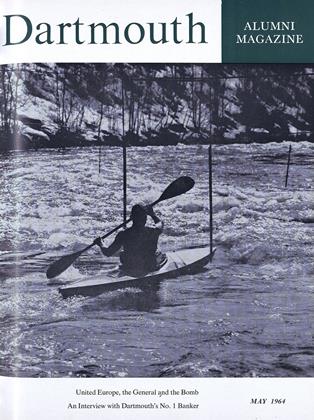SLALOM racing used to end when the spring sunshine sent the snows flooding down the mountain rivers. That was back in the days when kayaks were just for Eskimos and only Navy "frogmen" used rubber wet suits. Now combining all these into one of the most exciting new activities at Dartmouth is "white-water kayak slalom racing."
Early in April the Ledyard Canoe Club kayakists opened their second racing season with a meet on the Mascoma River in Lebanon. The river was full and fast, but even the less experienced competitors completed their runs through the gates and around the rocks.
Jay Evans '49, club adviser, long-time kayakist, and winner of the race, attributed this success to the twice-weekly practice sessions held in the new pool during the winter. In its warm and placid waters the technique of the "Eskimo roll" - where the kayakist turns the boat (and himself) over and then right side up by use of his paddle - could be learned, and blade techniques perfected.
Kayaking has been growing fast, especially in Europe, since the advent of fiberglass and increase in leisure time after World War II. The first world championship race was held in 1953 near Geneva, Switzerland, and today there are more than 400 white-water boating clubs in West Germany alone. The United States has held national and regional championships since 1956. Dartmouth, by its easy access to white water and head start with what is perhaps the first collegiate kayaking organization in the country, is in position to be a leader in the sport.
There are some half-dozen serious racers in the Ledyard Club and several others whose interest is less competitive. Two members, Chris Knight and Brad Dewey, are among the best in the East. Chris placed third in last year's Eastern Championships and Brad was second in the international Peterborough Slalom held near Toronto last summer. Adviser Evans, who is assistant to the Director of Admissions when not on the water, won last year's Hudson River White Water Derby.
Most of the boats at Dartmouth were built in the Hopkins Center workshops on the club's own fiberglass mold. There, $70 together with some 40 hours of work produces 33 pounds of rugged and maneuverable kayak. Commercial cost would be about $200. Another $30 to $40 for a wet suit, a little more for a paddle, and the kayakist is ready for the challenge of the snow-fed rivers.
To stiffen the challenge, the club set up a slalom course on the Mascoma last year. Ex-hockey sticks striped red and green were suspended four to five feet apart from a wire stretched over the water to mark the gates. Additional spice was added by making some of these "upstream" gates, which had to be taken against the current; others were "reverse" gates to be passed through backwards, and unlike skiing, the slaloming kayakist will lose points for barely touching a pole.
Even before this spring's race the club had begun daily workouts in preparation for the big eastern races, particularly the Eastern Championships. These will be held in mid-May on the West River near Jamaica, Vt., and the Dartmouth contingent will be a strong contender for the top team honors. Next step from there may be Buena Vista, Colo., for the national championship race in June.
Freshman Joe Knight running the slalom course on the Mascoma River.
 View Full Issue
View Full Issue
More From This Issue
-
 Feature
FeatureUNITED EUROPE, THE GENERAL AND THE BOMB
May 1964 By HENRY W. EHRMANN, -
 Feature
FeatureDARTMOUTH'S NO. 1 BANKER
May 1964 By DERO A. SAUNDERS '35, -
 Feature
FeatureA New Strategy of Liberal Learning
May 1964 -
 Article
ArticleTHE UNDERGRADUATE CHAIR
May 1964 By DAVE BOLDT '63 -
 Class Notes
Class Notes1936
May 1964 By BARRY C. SULLIVAN, GILBERT BALKAM -
 Class Notes
Class Notes1922
May 1964 By LEONARD E. MORRISSEY, CARTER H. HOYT








